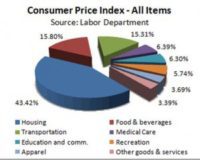Americans are obsessed with their income. It’s often treated as a scorecard, a yardstick for success. We talk about six-figure salaries, promotions with pay bumps, and high-paying industries like they’re the ultimate goal. But here’s the truth: income is only part of the story—and it’s not even the most important part. The real measure of success is your standard of living, and that depends heavily on where and how you live.
A few years ago, this concept came into sharp focus when one of my sons moved from Colorado Springs, Colorado, to Bentonville, Arkansas. On paper, he took a pay cut. But in practice, his life didn’t change much—at least not for the worse. That’s because Bentonville has a composite Consumer Price Index (CPI) that’s roughly two-thirds that of Colorado Springs. So, even with a small drop in salary, his purchasing power actually increased. In other words, his standard of living didn’t drop; it improved.
This example underscores a critical insight that many overlook: income is not the same as wealth or well-being. You could make $100,000 in New York City and struggle, while someone making $65,000 in Tulsa might live quite comfortably. Housing, groceries, utilities, taxes, and even gas prices all vary dramatically from city to city. It’s not just what you earn—it’s what your money can buy that matters.
Related Post: How to Master the Art of Choosing the Perfect Business Location
This reality was laid bare when COVID-19 hit and forced millions of people to work remotely. Suddenly, proximity to a corporate office in a major metro wasn’t necessary. People living in expensive urban areas like San Francisco or New York realized they could move to suburbia—or even rural America—where the cost of living was far lower. That shift didn’t just reduce their expenses; it increased their disposable income. A smaller mortgage, lower taxes, and cheaper groceries meant more money left over at the end of the month—without sacrificing the job that paid the bills. The pandemic didn’t just disrupt where we work; it revolutionized how we think about income and quality of life.
And this principle doesn’t only apply to personal finance. Businesses are subject to the same economic forces. Location influences everything from rent and utility costs to wages and taxes. That’s why smart entrepreneurs are increasingly factoring cost-of-living metrics into their strategic decisions.
For instance, a manufacturing client of mine is seriously considering relocating her business just forty miles south—from Colorado Springs to Pueblo, Colorado. Why? Because the CPI in Pueblo is about 25% lower. That’s a significant drop in overhead costs for things like rent, utilities, and even wages. By making a relatively short move, she stands to dramatically improve her margins without compromising her workforce or customer access.
Relocation isn’t always easy, and it’s not the right move for every business. But it’s a powerful option that too few entrepreneurs consider. We tend to get attached to our current location—our routines, our networks, even the perceived prestige of a zip code. But when you take a hard look at the numbers, a small geographic shift can make a big financial impact.
So how can you evaluate whether a move makes sense for your business? Start with these questions:
- What are your biggest fixed costs, and how do they compare to nearby cities?
- Could you access the same labor pool—or even better talent—at a lower wage elsewhere?
- Would a move bring you closer to suppliers or customers?
- How would taxes and regulatory burdens change?
You can use tools like Cost of Living Index calculators or regional CPI data to make apples-to-apples comparisons. And if you’re thinking about broader economic strategy, relocating your business might align with your long-term goals of growth, efficiency, or even lifestyle.
At the end of the day, your environment shapes your financial reality—both personally and professionally. Instead of chasing a higher paycheck or obsessing over revenue, take a step back. Ask yourself: are you making the most of what you already have? Could a change in scenery help you live or operate better?
We often think of “moving up” in terms of climbing a corporate ladder or hitting a revenue milestone. But sometimes, moving sideways—or just 40 miles down the road—can unlock even greater opportunities.
Has your income—or your business’s revenue—blinded you to the possibility that a better standard of living or higher profit margin might lie just a few miles away?












